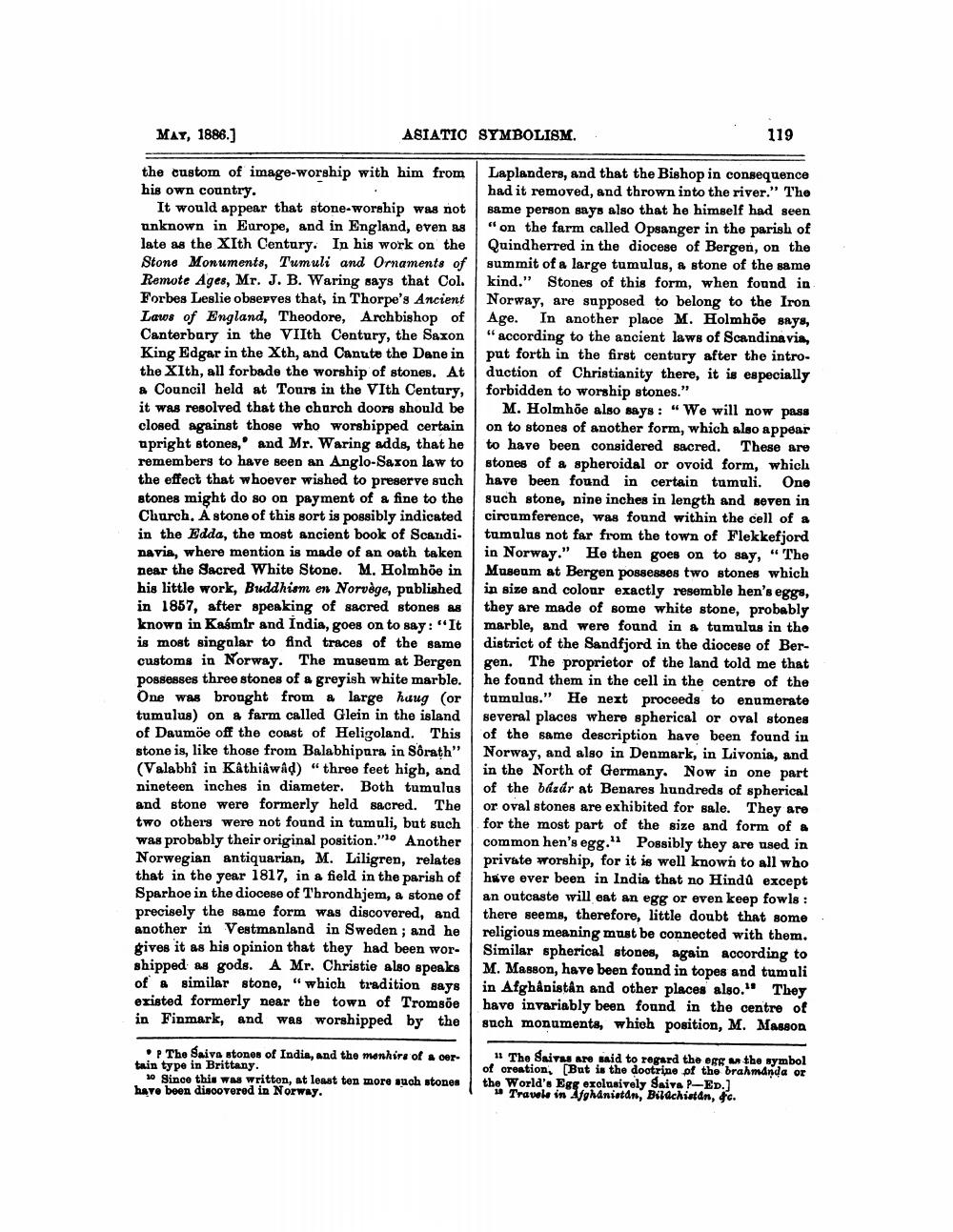________________
MAY, 1886.)
ASIATIC SYMBOLISM..
119
the custom of image-worship with him from his own country.
It would appear that stone-worship was not unknown in Europe, and in England, even as late as the XIth Century. In his work on the Stone Monuments, Tumuli and Omaments of Remote Ages, Mr. J. B. Waring says that Col. Forbes Leslie observes that, in Thorpe's Ancient Laws of England, Theodore, Archbishop of Canterbury in the VIIth Century, the Saxon King Edgar in the Xth, and Canute the Dane in the XIth, all forbade the worship of stones. At a Council held at Tours in the VIth Century, it was resolved that the church doors should be closed against those who worshipped certain upright stones, and Mr. Waring adds, that he remembers to have seen an Anglo-Saxon law to the effect that whoever wished to preserve such stones might do so on payment of a fine to the Church. A stone of this sort is possibly indicated in the Edda, the most ancient book of Scandi. navia, where mention is made of an oath taken near the Sacred White Stone. M. Holmhöe in his little work, Buddhism en Norvège, published in 1857, after speaking of sacred stones as known in Kasmir and India, goes on to say: "It is most singalar to find traces of the same customs in Norway. The museum at Bergen possesses three stones of a greyish white marble. One was bronght from & large huug (or tumulus) on a farm called Glein in the island of Daumöe off the coast of Heligoland. This stone is, like those from Balabhipara in Sôrath" (Valabbî in KathiÂwad) "three feet high, and nineteen inches in diameter. Both tumulus and stone were formerly held sacred. The two others were not found in tumuli, but such was probably their original position." Another Norwegian antiquarian, M. Liligren, relates that in the year 1817, in a field in the parish of Sparboe in the diocese of Throndhjem, a stone of precisely the same form was discovered, and another in Vestmanland in Sweden ; and he gives it as his opinion that they had been worshipped as gods. A Mr. Christie also speaks of a similar stone," which tradition says existed formerly near the town of Tromsoe in Finmark, and was worshipped by the
Laplanders, and that the Bishop in consequence had it removed, and thrown into the river." The same person anys also that he himself had seen "on the farm called Opsanger in the parish of Quindherred in the diocese of Bergen, on the summit of a large tumulus, a stone of the same kind.” Stones of this form, when found in Norway, are supposed to belong to the Iron Age. In another place M. Holmhõe says, "according to the ancient laws of Scandinavia, put forth in the first century after the introduction of Christianity there, it is especially forbidden to worship stones."
M. Holmhõe also says: “We will now pass on to stones of another form, which also appear to have been considered sacred. These are stones of a spheroidal or ovoid form, which have been found in certain tumuli. Ono such stone, nine inches in length and seven in circumference, was found within the cell of a tumulus not far from the town of Flekkefjord in Norway." He then goes on to say, “The Museum at Bergen possesses two stones which in size and colour exactly resemble hen's eggs, they are made of some white stone, probably marble, and were found in a tumulus in the district of the Sandfjord in the diocese of Bergen. The proprietor of the land told me that he found them in the cell in the centre of the tumulus." He next proceeds to enumerate several places where spherical or oval stones of the same description have been found in Norway, and also in Denmark, in Livonia, and in the North of Germany. Now in one part of the bázdr at Benares hundreds of spherical or oval stones are exhibited for sale. They are for the most part of the size and form of a common hen's egg." Possibly they are used in private worship, for it is well known to all who have ever been in India that no Hindd except an outcaste will eat an egg or even keep fowls : there seems, therefore, little doubt that some religious meaning must be connected with them. Similar spherical stones, again according to M. Masson, have been found in topes and tumuli in Afghanistan and other places also." They havo invariably been found in the centre of such monuments, which position, M. Masson
The Saiva stones of India, and the menhirs of der tain type in Brittany.
10 Since this was writton, at least ten more such stones have been discovered in Norway.
11 The Sims are said to regard the egg us the symbol of orention, But is the doctrine of the brahmanda or the World'. Ege exclusively Saiva P-ED.)
Travele in 2fghanistan, Biidchistan, 4c.




